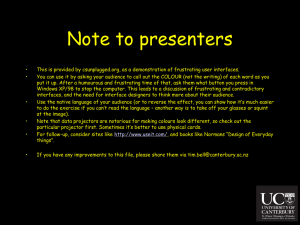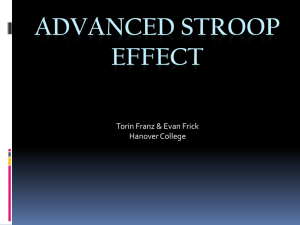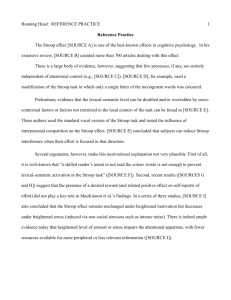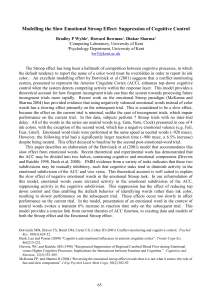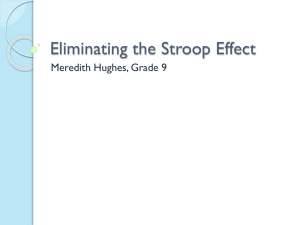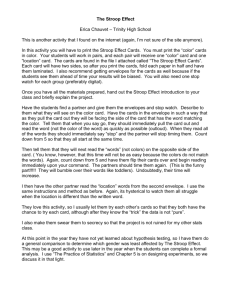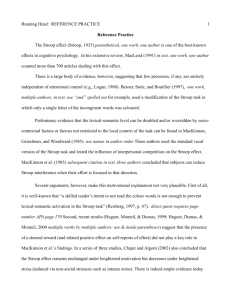An Optimal Viewing Position Effect in the Stroop Task When Only
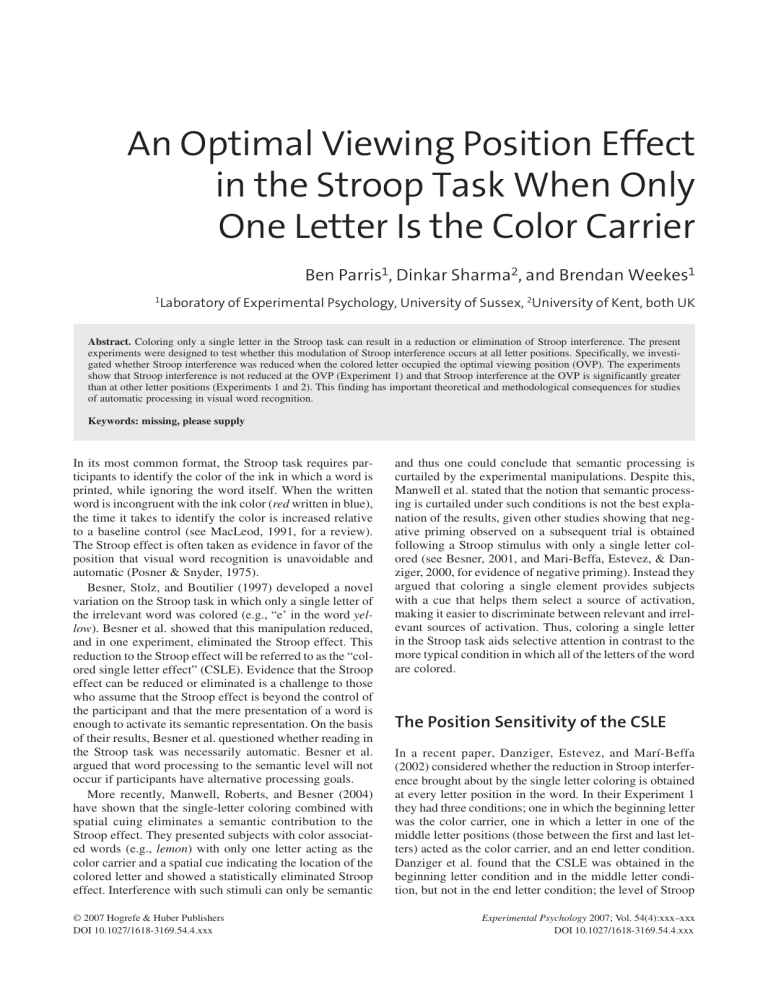
An Optimal Viewing Position Effect in the Stroop Task When Only
One Letter Is the Color Carrier
Ben Parris
1
, Dinkar Sharma
2
, and Brendan Weekes
1
1
Laboratory of Experimental Psychology, University of Sussex,
2
University of Kent, both UK
Abstract.
Coloring only a single letter in the Stroop task can result in a reduction or elimination of Stroop interference. The present experiments were designed to test whether this modulation of Stroop interference occurs at all letter positions. Specifically, we investigated whether Stroop interference was reduced when the colored letter occupied the optimal viewing position (OVP). The experiments show that Stroop interference is not reduced at the OVP (Experiment 1) and that Stroop interference at the OVP is significantly greater than at other letter positions (Experiments 1 and 2). This finding has important theoretical and methodological consequences for studies of automatic processing in visual word recognition.
Keywords: missing, please supply
In its most common format, the Stroop task requires participants to identify the color of the ink in which a word is printed, while ignoring the word itself. When the written word is incongruent with the ink color ( red written in blue), the time it takes to identify the color is increased relative to a baseline control (see MacLeod, 1991, for a review).
The Stroop effect is often taken as evidence in favor of the position that visual word recognition is unavoidable and automatic (Posner & Snyder, 1975).
Besner, Stolz, and Boutilier (1997) developed a novel variation on the Stroop task in which only a single letter of the irrelevant word was colored (e.g., “e’ in the word yellow ). Besner et al. showed that this manipulation reduced, and in one experiment, eliminated the Stroop effect. This reduction to the Stroop effect will be referred to as the “colored single letter effect” (CSLE). Evidence that the Stroop effect can be reduced or eliminated is a challenge to those who assume that the Stroop effect is beyond the control of the participant and that the mere presentation of a word is enough to activate its semantic representation. On the basis of their results, Besner et al. questioned whether reading in the Stroop task was necessarily automatic. Besner et al.
argued that word processing to the semantic level will not occur if participants have alternative processing goals.
More recently, Manwell, Roberts, and Besner (2004) have shown that the single-letter coloring combined with spatial cuing eliminates a semantic contribution to the
Stroop effect. They presented subjects with color associated words (e.g., lemon ) with only one letter acting as the color carrier and a spatial cue indicating the location of the colored letter and showed a statistically eliminated Stroop effect. Interference with such stimuli can only be semantic
© 2007 Hogrefe & Huber Publishers
DOI 10.1027/1618-3169.54.4.xxx
and thus one could conclude that semantic processing is curtailed by the experimental manipulations. Despite this,
Manwell et al. stated that the notion that semantic processing is curtailed under such conditions is not the best explanation of the results, given other studies showing that negative priming observed on a subsequent trial is obtained following a Stroop stimulus with only a single letter colored (see Besner, 2001, and Mari-Beffa, Estevez, & Danziger, 2000, for evidence of negative priming). Instead they argued that coloring a single element provides subjects with a cue that helps them select a source of activation, making it easier to discriminate between relevant and irrelevant sources of activation. Thus, coloring a single letter in the Stroop task aids selective attention in contrast to the more typical condition in which all of the letters of the word are colored.
The Position Sensitivity of the CSLE
In a recent paper, Danziger, Estevez, and Marí-Beffa
(2002) considered whether the reduction in Stroop interference brought about by the single letter coloring is obtained at every letter position in the word. In their Experiment 1 they had three conditions; one in which the beginning letter was the color carrier, one in which a letter in one of the middle letter positions (those between the first and last letters) acted as the color carrier, and an end letter condition.
Danziger et al. found that the CSLE was obtained in the beginning letter condition and in the middle letter condition, but not in the end letter condition; the level of Stroop
Experimental Psychology 2007; Vol. 54(4):xxx–xxx
DOI 10.1027/1618-3169.54.4.xxx
2 B. Parris et al.: Optimal Viewing Position Effect in Stroop Task interference at the end position did not differ from that obtained in the condition in which all the letters of the word were colored (the common Stroop format). In a subsequent experiment Danziger et al. colored either the first or the last half of the irrelevant word instead of just one letter. The results showed that interference was greatest when the last half of the word was colored. Danziger et al. accounted for these effects by suggesting that the processing of the colored and noncolored segments of the irrelevant word is separate and different. They suggested that the colored part of the irrelevant word is suppressed leaving the noncolored part of the word to be processed and thus to interfere with the color naming process. When the end part of the word is the color carrier (e.g., ue in blue ), the beginning part of the word is left to interfere with color processing. As the beginning part of the word produces most interference (see
Singer, Lappin, & Moore, 1975), it interferes more than if the end of the word were processed.
In the Danziger et al. study their middle position condition included any intermediate position between the beginning and end letters. This had the consequence of missing out a potentially interesting position-sensitive effect at a position first identified in the eye movement literature
(O’Regan, Lévy-Schoen, Pynte, & Brugaillère, 1984). Researchers investigating eye movements in reading have shown that readers tend to make their first fixation between the beginning and middle of a word (Dunn-Rankin, 1978;
O’Regan, 1981; Rayner, 1979; Vitu, 1991). Rayner (1979) originally labeled this location the “preferred viewing location” (PVL). O’Regan and Levy-Schoen (1987) distinguished between this position and the “optimal viewing position” (OVP). The OVP is located a bit to the right of the
PVL, closer to the center of the word. For present purposes, what is important about the OVP is that it has been shown to be the position at which word recognition time is shortest in both reading aloud and lexical decision tasks (O’Regan et al., 1984; O’Regan & Jacobs, 1992). It is conceivable therefore that this position might retain a large Stroop interference effect when it is the color carrier, as any benefit the single letter coloring may confer onto task performance might be lost to a more efficiently processed irrelevant dimension. Such a finding would be of value as it could provide important theoretical and methodological consequences for studies of automatic processing in visual word recognition.
Experiment 1
The aim of this experiment was to test for position-sensitivity of the CSLE at the OVP. It was expected that there would be a reduction in Stroop interference at all the single-letter positions except the OVP. In other words, it was predicted that there will be no CSLE at the OVP. Moreover, it was predicted that that the Stroop effect at the OVP would be larger than in the other single letter conditions.
Experimental Psychology 2007; Vol. 54(4):xxx–xxx
Four single letter positions were sampled. The two external letter positions were sampled, as was the position just to the left of the word’s center; this letter position approximates the OVP (O’Regan & Jacobs, 1992). The position to the right of the OVP (referred to as middle-letter condition) was also colored to permit a comparison between the
OVP and another internal letter position.
Method
Participants
48 students from the University of Sussex were paid to participate. They ranged in age from 18 to 49 years. The average age was 21.6 years.
Stimuli
All stimuli were presented in lowercase and were created in Microsoft Paint version 5.0 using Times New Roman font. The ink colors used were brown (RGB: 128, 64, 0), green (RGB: 0, 255, 0), blue (RGB: 0, 0, 255) and yellow
(RGB: 255, 255, 0), and grey (RGB: 192, 192, 192) for the letters of the word that were not the “color carrier.” The stimuli consisted of the color words brown (25 mm long ×
8 mm high; 2.4° × .76°), yellow (28 mm long × 8 mm high;
2.7° × .76°), green (22 mm long × 8 mm high; 2.1° × .76°), and blue (17 mm long × 8 mm high; 1.6° × .76°) and the neutral words stage (21 mm long × 8 mm high; 2° × .76°), plenty (25 mm long × 8 mm high; 2.4° × .76°), plane
(23 mm long × 8 mm high; 2.2° × .76°) and club (18 mm long × 8 mm high; 1.7° × .76°). The neutral words were matched to the color words for word length and frequency
(Kucera & Francis, 1967). In the practice session the stimuli consisted of a string of five repeated X’s. The stimuli were presented on black background using a gateway solo
P2-550 laptop pc using a TFT screen with a refresh rate of
60 Hz. The experiment was programmed using Superlab
Pro Version 2.0.
Design and Procedure
A 2 (Word Type: Incongruent, neutral) × 5 (Coloring: Allletters, initial-letter, OVP, middle-letter, and end-letter) within-subjects design was used. Participants were tested individually and sat approximately 60 cm from the screen.
Initially participants were presented with a screen showing a series of strings of X’s in the colors used in the experiment. They were asked to name the colors one by one. If they successfully named all the colors, they were shown examples of strings of X’s that were either fully colored or had just one letter as the color carrier. When just one letter was the color carrier, the remaining letters were colored in a neutral grey, on a black background. They were then pro-
© 2007 Hogrefe & Huber Publishers
B. Parris et al.: Optimal Viewing Position Effect in Stroop Task 3 vided with verbal instructions informing them that their task was to name the color of the print quickly and accurately, and to ignore the irrelevant word, irrespective of which letter was colored. Each participant was asked to complete a practice session consisting of 36 trials. There were 168 trials in the experiment; 72 trials were fully colored stimuli and the remaining 96 trials had only one letter colored. There were 24 of each of the single-letter conditions. Each color word (and its matched neutral word) was presented in one of the three incongruent ink colors. Each word was presented as fully colored and with each of the chosen letter positions as the color carrier. All the stimuli were presented in a random order such that the participant did not know if the stimulus to be presented was fully colored or partially colored, or if partially colored, which letter would be colored. A fixation cross was presented at the center of the screen for 350 ms. The Stroop stimuli replaced the fixation cross such that the word’s center appeared at fixation. The stimuli remained on screen until the participant made a response, which initiated a one second interstimulus interval. A microphone connected to the laptop registered response latencies. Verbal responses were recorded to enable detection of errors and accidental voice key triggers.
Table 1.
Mean reaction times (ms), standard errors, and percentage errors when identifying color as a function of position in Experiment 1.
OVP All letters
Incongruent RT 840
SE
%E
20
2.14
Neutral
Interference
RT 735
SE 13
%E 0.5
105
Initial letter
829
19
3.6
755
14
0.87
74
871
22
1.7
754
16
0.17
116
Middle letter
806
22
1.7
736
16
0
70
End letter
821
4
17
1.0
775
7
14
0.8
46
Results
Analyses were conducted on mean correct response latencies only. This is true for the two experiments presented in this article – the error data produced no effects of interest and showed no signs of speed-accuracy tradeoff (see tables for percentage errors). The correct response latencies were subjected to a trimming procedure in which the criterion cut-off for outlier removal is established independently for each participant, for each condition, by reference to the sample size in that condition (Van Selst & Jolicoeur, 1994).
1.1% of the data were counted as errors and 0.5% of the data were removed because they represented an inappropriate triggering of the voice key.
Position Effect Analysis
Mean reaction time and error data for all letter position conditions are reported in Table 1. Only data from the single-letter conditions were entered into these analyses. The reaction time data were entered into a 2 (Word type: Incongruent vs. neutral) × 4 (Position: Initial-letter, OVP, middle-letter, and end-letter) repeated measures ANOVA. The analysis revealed a main effect of word type F (1, 47) =
44.86, MSe = 12527.86, p < .001, indicating that response times were longer to the incongruent stimuli, a main effect of position, F (3, 141) = 5.83, MSe = 4805.76, p = .001, and an interaction of Word Type × Position, F (3, 141) = 4.94,
MSe = 4222.150, p < .01.
Analyzes revealed a Stroop effect at every position: Ini-
© 2007 Hogrefe & Huber Publishers tial-letter t (47) = 6.13, p < .001; OVP t (47) = 5.07, p <
.001; middle-letter t (47) = 4.52, p < .001; end-letter t (47) =
3.91, p < .001.
As can be seen from Table 1, the position effect seems to be caused by the larger Stroop effect at the OVP. To confirm this, the Stroop effect in the OVP condition was compared to those in the other single-letter conditions.
Since it was predicted that Stroop interference would be greatest in the OVP condition all pvalues are reported as one-tailed. To control for familywise error rate Holm’s sequential Bonferroni procedure was employed. Analyzes are reported in order of pvalue magnitude for Holm’s sequential Bonferroni procedure. Analyzes revealed that for
OVP v end-letter t (47) = 3.580, p < .001; for OVP v middle-letter, t (47) = 2.207, p = .016; and for OVP v initialletter t (47) = 1.926, p = .030. Using this test the comparisons have to be significant at the .05/3 = .0167, .05/2 =
.025, and .05/1 = .05 levels, respectively. Therefore, the
OVP condition produced a Stroop effect that was significantly larger than all of the other single-letter conditions.
It was predicted that the Stroop effect in the all-letters condition would be greater than all the single letter conditions other than the OVP condition. Analyzes revealed that this prediction was supported (all pvalues are reported as one-tailed): All v end-letter t (47) = 4.746, p < .001; all v middle-letter t (47) = 2.599, p = .006; all v initial-letter t (47) = 2.549, p = .007; all v OVP t (47) = .571, p = .285.
Holm’s sequential Bonferroni procedure was again employed to correct for multiple comparisons. To be significant pvalues had to be less than .05/4 = .0125, .05/3 =
.0167, .05/2 = .025, .05/1 = .05, respectively. Therefore, all single letter positions, except the OVP showed the CSLE.
Discussion
Our most important finding is that a full Stroop effect is observed when the color carrier is just to the left of the center of the irrelevant word, whereas in other single-letter conditions including the middle-letter condition, substan-
Experimental Psychology 2007; Vol. 54(4):xxx–xxx
4 B. Parris et al.: Optimal Viewing Position Effect in Stroop Task tial reductions in interference are observed. In other words, the CSLE was found in all single-letter conditions except the OVP condition. Analyzes revealed that the OVP condition produced a Stroop effect that was significantly larger than the Stroop effects in all the remaining single-letter conditions.
Besner et al. (1997) showed an elimination of the Stroop effect in their single letter condition. We found no such elimination at any of the sampled positions. This could be due to the use of the vocal response mode in our study which has been shown to produce greater Stroop interference than the manual response in the colored single letter
Stroop task (Brown, Joneleit, Robinson, & Brown, 2002).
Another possible reason for the lack of an elimination of the Stroop effect is the use of a neutral word baseline condition. When Besner et al. obtained the elimination of the
Stroop effect they employed nonwords that had the same first two letters as the color words used in the experiment.
Such baselines have been shown to produce Stroop effects when compared to a neutral word baseline (Tzelgov, Henik,
Sneg, & Baruch, 1996) and are thus more likely to eliminate reaction time differences between incongruent and neutral conditions in the Stroop task.
The argument that the position effect obtained in this experiment is caused by the OVP is complicated by the fact that the OVP effect has been identified in studies of word naming and lexical decision when the OVP is at the location of initial fixation. That is, all studies investigating the
OVP in the visual word recognition literature present the words so that the letter position under investigation appears at the point of initial fixation; the word is shifted horizontally around the center of the screen to allow each position to be sampled. When the OVP is the position at the center of the screen, visual word recognition time is shortest
(O’Regan et al. 1984; O’Regan & Jacobs, 1992). The aim of the next experiment was to apply this methodology to the colored single letter Stroop task.
Initial
OVP
End
Fixation Cue
OVP conditions.
g gree g r n
+ reen een
Figure 1.
Example of the paradigm employed in Experiment 2. The bolded letter represents the colored letter. The fixation cue is presented in the center of the screen. One of the stimuli immediately replaces the cue in the center of the screen. The colored letter is located at the screen center.
Only one stimulus is presented at a time.
every trial. To sample the chosen letter positions the Stroop stimulus was shifted laterally about the central fixation cue
(see Figure 1). This design has the effect of controlling the location of initial fixation. It was predicted that controlling for initial fixation position would produce similar effects to Experiment 1 because it is likely that in Experiment 1 the colored letter captured attention. The middle-letter condition was not included in this experiment because it was the position of initial fixation in Experiment 1 (for the words green and brown ) and the Stroop effect obtained was significantly different from that in the all-letters and the
Method
Participants
20 students from the University of Sussex were paid to participate. They ranged in age from 19 to 38 years. The average age was 22 years.
Experiment 2
The aim of Experiment 2 was to test whether a position effect would be found when the colored letter was at the position of initial fixation. In Experiment 1, it is unlikely that participants were able to immediately fixate the colored letter on presentation of the stimulus because the sampled position was randomized on a trial-by-trial basis. It is more likely that participants fixated the center of the stimulus when it was present because central fixation marker would have cued them to that location. Participants would have then oriented their attention to the location of the colored letter, probably after capture (Brown et al., 2002; Folk,
Remington, & Johnston, 1992; Treisman & Gelade, 1980).
In this experiment, the colored letter was always presented at the center of the screen. This meant that the central fixation cross indicated the location of the colored letter on
Experimental Psychology 2007; Vol. 54(4):xxx–xxx
Stimuli
As in Experiment 1.
Design and Procedure
As in Experiment 1 except for the way in which the words were presented (see Figure 1) and that there were only 72 single-letter colored Stroop trials, 24 in each of the singleletter conditions (initial-letter, end-letter, OVP).
© 2007 Hogrefe & Huber Publishers
B. Parris et al.: Optimal Viewing Position Effect in Stroop Task 5
Table 2.
Mean reaction times (ms), standard errors, and percentage errors when identifying color as a function of position in Experiment 2
Incongruent
Neutral
Interference
RT
SE
%E
RT
SE
%E
Initial letter OVP
757
26
2.1
778
19
2.1
719
19
0.4
38
691
16
0.4
87
End letter
795
24
1.25
755
19
0.4
40
Results
The correct response latencies were subjected to the same trimming procedure as used in Experiment 1. 1.5% of the data were counted as errors and 0.9% of the data were removed because they represented an inappropriate triggering of the voice key. Mean reaction time and error data for all conditions are in Table 2.
The data were entered into a 2 (Word type) × 3 (Position) repeated-measures ANOVA. The analysis produced a main effect of word type F (1, 19) = 28.211, MSe = 3231.08, p <
.001, main effect of position F (2, 38) = 9.164, MSe =
2214.87, p = .001, and an interaction of word type × position F (2, 38) = 5.385, MSe = 1452.93, p = .009.
A paired samples t -test was conducted on each of the single-letter conditions to test for Stroop effects at each position. The results yielded a significant Stroop effect at every position; initial-letter t (19) = 1.984, p = .062 (taken as significant); OVP t (19) = 7.957, p < .001; end-letter t (19) = 3.530, p = .002.
To confirm that the OVP is the cause of the interaction, pairwise comparisons were conducted. The Stroop effects at each of the positions were compared (reported as onetailed): Initial-letter vs. OVP t (19) = 3.637, p = .001; OVP vs. end-letter t (19) = 3.007, p = .003; initial-letter vs. endletter t (19) = .109, p > .4. Holm’s sequential Bonferroni procedure was used to control for familywise error rate.
Using this procedure the comparisons have to be significant at the .05/3 = .0167, .05/2 = .025, and .05/1 = .05 levels, respectively. Therefore, only the comparisons involving the OVP were significant.
Discussion
The paradigm employed in this experiment is similar to that used to identify the OVP effect in word reading. The results are clear. The Stroop effect in the OVP condition is larger than in both the initial- and end-letter conditions as revealed by the interaction of word type and position. This provides strong support for the notion that the position-sensitivity of the
CSLE observed in Experiment 1 is due to the influence of the
OVP effect identified in the eye movement literature.
© 2007 Hogrefe & Huber Publishers
General Discussion
The aim of the present set of experiments was to identify whether the OVP, defined as the position at which word recognition time is shortest (O’Regan et al. 1984; O’Regan & Jacobs, 1992), would show a reduction in Stroop interference when acting as the color carrier in the Stroop task. The results from two experiments showed that the
OVP is treated differently from other single letter positions. Manwell et al. (2004) have argued that coloring a single element provides subjects with a cue that helps them select a source of activation, making it easier to discriminate between relevant and irrelevant sources of activation. Thus, in contrast to situations in which all of the letters of the word are colored, coloring only a single letter in the Stroop task aids selective attention. The results from the present experiments show that selective attention is aided by the single letter coloring at the initial, middle and end letter positions, as a significant reduction in Stroop interference is observed. This does not hold at the OVP however. When the color carrier is at the OVP the selection of a source of activation is difficult, and akin to the selection difficulties observed when all the letters of the word are colored. Thus, coloring a single letter at the OVP makes the irrelevant dimension more salient.
A question that remains is how the OVP makes the irrelevant dimension more salient? To offer a potential answer to this question one has to consider how single letter coloring exerts its effect. Besner and Stolz (1999) combined single letter coloring with the spatial cueing paradigm. The spatial cueing paradigm is generally thought to influence the distribution of spatial attention across a stimulus or display. The condition in which the cue was at the colored letter’s location resulted in reduced Stroop interference compared to conditions in which just spatial cueing was used or one of the letters that was not the color carrier was spatially cued. It is not clear that the two manipulations operate in the same way, but one assumption that follows is that the coloring of a single letter enhanced the spatial cueing effect’s influence on the distribution of spatial attention. If this assumption is accepted, it leads to the possibility that the OVP effect observed in the present set of experiments is due to the OVP being resistant to this manipulation of spatial attention; a possibility that finds support in the OVP literature (Faird & Grainger, 1996;
Nazir, Deutsch, Grainger, & Frost, 2000; Stevens &
Grainger, 2003; see also Ducrot & Pynte, 2002).
Stevens and Grainger (2003) have suggested that the
OVP is the position at which letters with the highest conditional letter position probabilities are most visible.
Viewing the word at the OVP, they argue, makes the informative parts of the word and its constituent letters more visible, enabling better word recognition. Research has shown that the location of the OVP is in part determined by the manner in which attention is deployed across a letter string in any given language (Farid & Grainger, 1996;
Experimental Psychology 2007; Vol. 54(4):xxx–xxx
6 B. Parris et al.: Optimal Viewing Position Effect in Stroop Task
Nazir et al., 2000; see also Ducrot & Pynte, 2002). For example, Nazir et al. have shown that the OVP is just to the right of center in Hebrew, a language that is read from right-to-left. The OVP effects in this study might therefore be a consequence of the OVP being the position from which attention is optimally spread across a word in ordinary reading conditions. As a consequence it would be more difficult for manipulations of spatial attention, such as spatial cuing or single letter coloring, to exert their effects at this position. Coloring a single letter at the OVP would then make the irrelevant dimension more salient, leading to better word recognition, and greater response competition. Further research could employ the spatial cueing procedure and the single letter coloring manipulations and contrast their individual and combined effects at the OVP to identify the role of spatial attention in causing the OVP effect observed in the present experiments 1 .
Monahan (2001) has suggested an alternative explanation of the CSLE. He argued that single letter coloring acts to slow color processing, instead of changing the way in which the irrelevant word is processed. Monahan based his argument on the fact that in the study by Besner et al.
(1997) the single letter coloring affects reaction times to neutral stimuli only. Searching for the colored letter increases reaction times to both neutral and incongruent stimuli under his explanation, but the effect is only seen in the neutral stimuli because reaction times to incongruent stimuli increase as a result of response competition and any increase associated with visual search is therefore hidden. What is clear from Table 1 is that the middle-letter condition does show the CSLE, but is the result of a 34 ms reduction in reaction time to the incongruent stimuli with only a 1 ms increase to the neutral stimuli, a pattern not predicted by Monahan. Moreover, it would be difficult to account for the OVP effect under Monahan’s argument.
The position-sensitive effect we report is contrary to the findings of Danziger et al. (2002) who found a larger
Stroop effect when the colored letter appeared at the end of the word (see their Experiment 1). Our data show no such effect at the end position. It is in fact the position in which the smallest Stroop effect is obtained in Experiment
1. In Experiment 2, however, reaction times were slowest in the end letter condition for both neutral and incongruent words, a finding that highlights a special role for the endletter position in this task. Moreover, reaction times were actually fastest for neutral words in the OVP condition of
Experiment 2, which is inconsistent with the notion that it is the position at which interference, including nonresponse related interference, is greatest. Nevertheless,
Stroop interference was greatest at the OVP in both experiments. Future studies are needed to explore the different patterns of reaction times observed in the present experiments and those observed in the Danziger et al. study
2
.
One difference between the two studies is the baseline condition used. In the present study we used neutral words as our baseline whereas Danziger et al. used a string of repeated X’s. The use of strings of X’s may have caused the stimuli to have been processed differently
3
. Danziger et al. also used Spanish participants that were tested in
Spanish. The OVP effect in word reading has been identified in French, Dutch, Hebrew, Arabic, and Japanese
(Brysbaert & Nazir, 2005). As far as we are aware there is no reported evidence of an OVP effect in Spanish. The location of the OVP has been shown to be modulated by language. In languages that read from right to left, the
OVP has been shown to be at the center, or to the right of the center of the word (Farid & Grainger, 1996; Nazir et al, 2000). It is conceivable therefore that the Spanish language, with its highly transparent orthography, may have an OVP located at some other point in the word. However,
Danziger et al. did not specifically sample the known location for the OVP when investigating possible position sensitivity in the CSLE. They selected various medial positions and treated these positions as one condition. It is possible therefore that this selection procedure resulted in hiding the effects at the OVP. This does not explain, however, why we obtained a reduction in Stroop interference at the end letter position when they did not.
A further difference between our two studies is response mode. Studies have shown that lexical distractors impinge more on processing when the response is vocal compared to when the response is manual (Baldo, Shimamura, & Prinzmetal, 1998; Virzi & Egeth, 1985). It is possible, therefore, that the OVP effect, would not be obtained when the response is manual. It is also possible that the two response modes permit different influences on attention. Contrary to this, however, is data we have previously presented that is suggestive of an OVP effect with a manual response (Parris, Sharma, & Weekes, 2002), and that showed no evidence of an end position effect.
In conclusion, these findings show that the OVP can moderate performance in the Stroop task when only one letter is the color carrier. The results highlight the importance of the OVP in single word processing and bring together the two relatively disparate literatures of eye movements in reading and automaticity in visual word recognition. Moreover, these results invite modelers of visual word recognition and the Stroop task to include the OVP as a moderator of performance (see also O’Regan & Jacobs, 1992).
1 We thank Derek Besner for this suggestion.
2 A straightforward comparison between our experiments and Danziger et al. may be difficult due to the use of a different neutral condition, response mode, and pretrial knowledge of the location of the colored letter on the screen.
3 We thank Shai Danziger for this suggestion.
Experimental Psychology 2007; Vol. 54(4):xxx–xxx © 2007 Hogrefe & Huber Publishers
B. Parris et al.: Optimal Viewing Position Effect in Stroop Task 7
Author Note
This work was completed as part of a DPhil thesis which was started at the University of Kent under the provisional supervision of the second author (for a period of six months) and was completed at the University of Sussex in the Laboratory of Experimental Psychology (which is now the Department of Psychology) under the supervision of the third author.
References
Algom, D., Chajut, E., & Lev, S. (2004). A rational look at the emotional Stroop phenomenon: A generic slowdown, not a
Stroop effect.
Journal of Experimental Psychology-General,
133 , 323–338.
Baldo, J.V., Shimamura, A.P., & Prinzmetal, W. (1998). Mapping symbols to response modalities: Interference effects on
Stroop-like tasks.
Perception & Psychophysics, 60 ,
427–437.
Besner, D. (2001). The myth of ballistic processing: Evidence from Stroop’s paradigm.
Psychonomic Bulletin & Review, 8 ,
324–330.
Besner, D., & Stolz, J.A. (1999). What kind of attention modulates the Stroop effect?
Psychonomic Bulletin & Review, 6 ,
99–104.
Besner, D., Stolz, J.A., & Boutilier, C. (1997). The Stroop effect and the myth of automaticity.
Psychonomic Bulletin &
Review, 4 , 221–225.
Brown, T.L., Joneleit, K., Robinson, C.S., & Brown, C.R.
(2002). Automaticity in reading and the Stroop task: Testing the limits of involuntary word processing.
American Journal of Psychology, 115 , 515–543.
Brysbaert, M. & Nazir, T. (2005). Visual constraints in written word recognition: Evidence from the optimal viewing-position effect.
Journal of Research in Reading, 28 , 216–228.
Cohen, J.D., Dunbar, K., & McClelland, J.L. (1990). On the
Control of Automatoc Processes: A Parallel Distributed Processing Account of the Stroop Effect.
Psychological Review,
97 , 332–361.
Danziger, S., Estevez, A.F., & Mari-Beffa, P. (2002). Stroop interference effects in partially colored Stroop words.
Psychonomic Bulletin & Review, 9 , 536–541.
Ducrot, S., & Pynte, J. (2002). What determines the eyes’ landing position in words?
Perception & Psychophysics, 64 ,
1130–1144.
Dunn-Rankin, P. (1978). The visual characteristics of words.
Scientific American, 238 , 122–130.
Farid, M., & Grainger, J. (1996). How initial fixation position influences visual word recognition: A comparison of French and Arabic.
Brain and Language, 53 , 351–368.
Folk, C.L., Remington, R.W., & Johnston, J.C. (1992). Involuntary covert attention is contingent on attentional control settings.
Journal of Experimental Psychology: Human Perception and Performance, 18, 1030–44.
Howell, D. (2002).
Statistical methods for psychology (5th ed.).
Pacific Grove, CA: Duxbury.
Inhoff, A.W., & Rayner, K. (1986). Parafoveal word processing
© 2007 Hogrefe & Huber Publishers during eye fixations in reading: Effects of word frequency.
Perception & Psychophysics, 40 , 431–439.
Kucera, H., & Francis, W.N. (1967).
Computational analysis of present day American English . Providence: Brown University Press.
MacLeod, C.M. (1991). Half a century of research on the
Stroop effect: An integrative review.
Psychonomic Bulletin,
109 , 163–203.
Manwell, L.A., Roberts, M.A., & Besner, D. (2004). Single letter coloring and spatial cueing eliminates a semantic contribution to the Stroop effect.
Psychonomic Bulletin & Review,
11 , 458–462.
Mari-Beffa, P., & Estévez, A.F., & Danziger, S. (2000). Stroop interference and negative priming: Problems with inferences from null results.
Psychonomic Bulletin and Review, 7,
499–503
Monsell, S., Taylor, T.J., & Murphy, K. (2001). Naming the color of a word: Is it responses or task sets that compete?
Memory & Cognition, 29 , 137–151.
Nazir, T.A., Deutsch, A., Grainger, J., & Frost, R. (2000). The role of early perceptual learning in reading.
Abstracts of the
Psychonomic Society, 5 , 83.
O’Regan, J.K. (1981). The convenient viewing position hypothesis. In D.F. Fisher, R.A. Monty, & J.W. Senders (Eds.),
Eye movements: Cognition and visual perception
(pp. 289–298). Hillsdale, NJ: Erlbaum.
O’Regan, J.K., & Levy-Schoen, A. (1987). Eye movement strategy and tactics in word recognition and reading. In M.
Coltheart (Ed.), Attention and performance XII: The psychology of reading (pp. 363–383). Hillsdale, NJ: Erlbaum.
O’Regan, J.K., & Jacobs, A.M. (1992). Optimal viewing position effect in word recognition – a challenge to current theory.
Journal of Experimental Psychology-Human Perception and Performance, 18 , 185–197.
O’Regan, J.K., Levy-Schoen, A., Pynte, J., & Brugailllere, B.
(1984). Convenient fixation location within isolated words of different length and structure.
Journal of Experimental Psychology-Human Perception and Performance, 10 , 250–257.
Parris, B., Sharma, D., & Weekes, B. (2002).
The Stroop effect and automaticity in visual word recognition.
Poster presented at the 43rd Annual Meeting of the Psychonomic Society,
Kansas, USA.
Posner, M.I., & Snyder, C.R.R. (1975). Attention and cognitive control. In R.L. Solso (Ed.), Information processing and cognition: The Loyola symposium . Hillsdale, NJ: Erlbaum.
Rayner, K. (1979). Eye guidance in reading: Fixation locations within words.
Perception, 8 , 21–30.
Rayner, K., & Duffy, S.A. (1986). Lexical complexity and fixation times in reading: Effects of word frequency, verb complexity, and lexical ambiguity.
Memory & Cognition, 14 , 191–201.
Rayner, K., & Fischer, M.H. (1986). Mindless reading revisited: Eye movements during reading and scanning are different.
Perception & Psychophysics, 58 , 734–747.
Singer, M.H., Lappin, J.S., & Moore, L.P. (1975). The interference of various word parts on color naming in the Stroop test.
Perception & Psychophysics, 18 , 191–193.
Stevens, M., & Grainger, J. (2003). Letter visibility and the viewing position effect in visual word recognition.
Perception and Psychophysics, 65 , 133–151.
Treisman, A., & Gelade. (1980). A feature integration theory of attention.
Cognitive Psychology, 12 , 97–136.
Experimental Psychology 2007; Vol. 54(4):xxx–xxx
8 B. Parris et al.: Optimal Viewing Position Effect in Stroop Task
Tzelgov, J., Henik, A., Sneg, R., & Baruch, O. (1996). Unintentional word reading via the phonological route: The
Stroop effect with cross-script homophones.
Journal of Experimental Psychology-Learning Memory and Cognition,
22 , 336–349.
Virzi, R.A., & Egeth, H.E. (1985). Toward a translational model of Stroop interference.
Memory & Cognition, 13 , 304–319.
Received June 14, 2006
Revision received August 22, 2006
Accepted September 11, 2006
Ben Parris
Department of Psychology
Washington Singer Laboratories
Perry Road
Exeter
Devon
UK
EX4 3BT
Tel. +44 1392 264647
E-mail b.a.parris@ex.ac.uk
Experimental Psychology 2007; Vol. 54(4):xxx–xxx © 2007 Hogrefe & Huber Publishers
